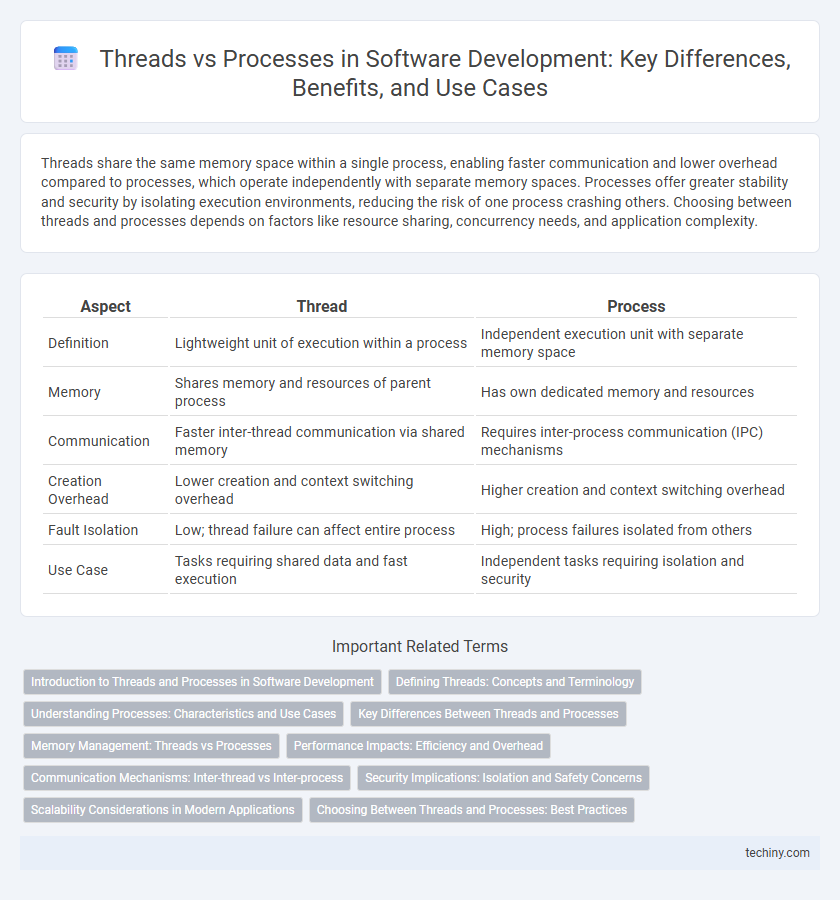Threads share the same memory space within a single process, enabling faster communication and lower overhead compared to processes, which operate independently with separate memory spaces. Processes offer greater stability and security by isolating execution environments, reducing the risk of one process crashing others. Choosing between threads and processes depends on factors like resource sharing, concurrency needs, and application complexity.
Table of Comparison
| Aspect | Thread | Process |
|---|---|---|
| Definition | Lightweight unit of execution within a process | Independent execution unit with separate memory space |
| Memory | Shares memory and resources of parent process | Has own dedicated memory and resources |
| Communication | Faster inter-thread communication via shared memory | Requires inter-process communication (IPC) mechanisms |
| Creation Overhead | Lower creation and context switching overhead | Higher creation and context switching overhead |
| Fault Isolation | Low; thread failure can affect entire process | High; process failures isolated from others |
| Use Case | Tasks requiring shared data and fast execution | Independent tasks requiring isolation and security |
Introduction to Threads and Processes in Software Development
Threads and processes serve as the fundamental units of execution in software development, with processes encapsulating a program's resources while threads enable concurrent operations within a single process. Processes operate in isolated memory spaces, ensuring strong separation but incurring higher overhead during creation and context switching. Threads share the same memory within a process, allowing faster communication and synchronization, making multithreading essential for optimizing application performance and resource utilization.
Defining Threads: Concepts and Terminology
Threads represent the smallest sequence of programmed instructions that can be managed independently by a scheduler within a process. They share the same memory space and resources of their parent process but maintain individual execution stacks and program counters, enabling concurrent execution. Understanding threads involves key concepts such as concurrency, synchronization, and context switching, which are essential for optimizing performance and resource utilization in software development.
Understanding Processes: Characteristics and Use Cases
Processes are independent execution units with their own memory space, system resources, and lifecycle, enabling isolation and stability in software applications. They are suitable for running multiple programs simultaneously, as each process operates separately, preventing errors in one from affecting others. Use cases include executing different applications, managing resource-intensive tasks, and enhancing security through process isolation.
Key Differences Between Threads and Processes
Threads share the same memory space within a single process, allowing for faster communication and context switching, while processes operate independently with separate memory spaces, enhancing stability and security. Processes require more overhead due to memory allocation and inter-process communication, whereas threads are lightweight with lower resource consumption. Understanding these distinctions is crucial for optimizing concurrency, resource management, and application performance in software development.
Memory Management: Threads vs Processes
Threads share the same memory space within a single process, enabling faster communication and lower overhead in memory management. Processes have isolated memory spaces, requiring more complex mechanisms for data sharing and increased memory usage. Efficient memory management in multithreading maximizes resource utilization, while processes enhance stability and security through separation.
Performance Impacts: Efficiency and Overhead
Threads offer superior performance efficiency compared to processes by enabling shared memory space, which reduces context-switching overhead and accelerates communication. Processes incur higher resource consumption due to isolated memory, leading to increased latency and CPU usage during inter-process communication. Optimizing application design to leverage multithreading effectively minimizes overhead and enhances responsiveness in concurrent execution environments.
Communication Mechanisms: Inter-thread vs Inter-process
Inter-thread communication occurs within the same process memory space, enabling faster data exchange through shared variables and synchronization primitives like mutexes and condition variables. Inter-process communication (IPC) involves more complex mechanisms such as pipes, message queues, shared memory, and sockets to transfer data across isolated memory spaces. IPC typically incurs higher latency and overhead due to context switching and kernel involvement, whereas inter-thread communication benefits from low-latency access but requires careful synchronization to avoid race conditions.
Security Implications: Isolation and Safety Concerns
Processes offer stronger security isolation by running in separate memory spaces, minimizing the risk of data leakage or corruption between them. Threads share the same memory within a process, increasing vulnerability to race conditions, data races, and unauthorized data access if synchronization mechanisms are weak or flawed. Choosing processes enhances protection against malicious attacks by isolating execution contexts, while threads require careful management to maintain safety and prevent security breaches.
Scalability Considerations in Modern Applications
Threads offer lightweight concurrency within a single process, sharing memory space, which enhances scalability for modern applications by enabling efficient resource utilization and faster context switching. Processes provide stronger isolation and fault tolerance but incur higher overhead due to separate memory spaces, limiting scalability in resource-constrained environments. Modern applications often combine multithreading and multiprocessing strategies to balance scalability, leveraging threads for parallel tasks and processes for modular, resilient components.
Choosing Between Threads and Processes: Best Practices
Choosing between threads and processes depends on factors like resource sharing, communication overhead, and fault isolation requirements. Threads share the same memory space, enabling faster communication but increasing the risk of concurrency issues, while processes have isolated memory spaces, providing stability at the cost of higher inter-process communication overhead. Best practices recommend using threads for tasks requiring frequent data sharing and processes when robustness and fault tolerance are critical.
Thread vs Process Infographic

 techiny.com
techiny.com